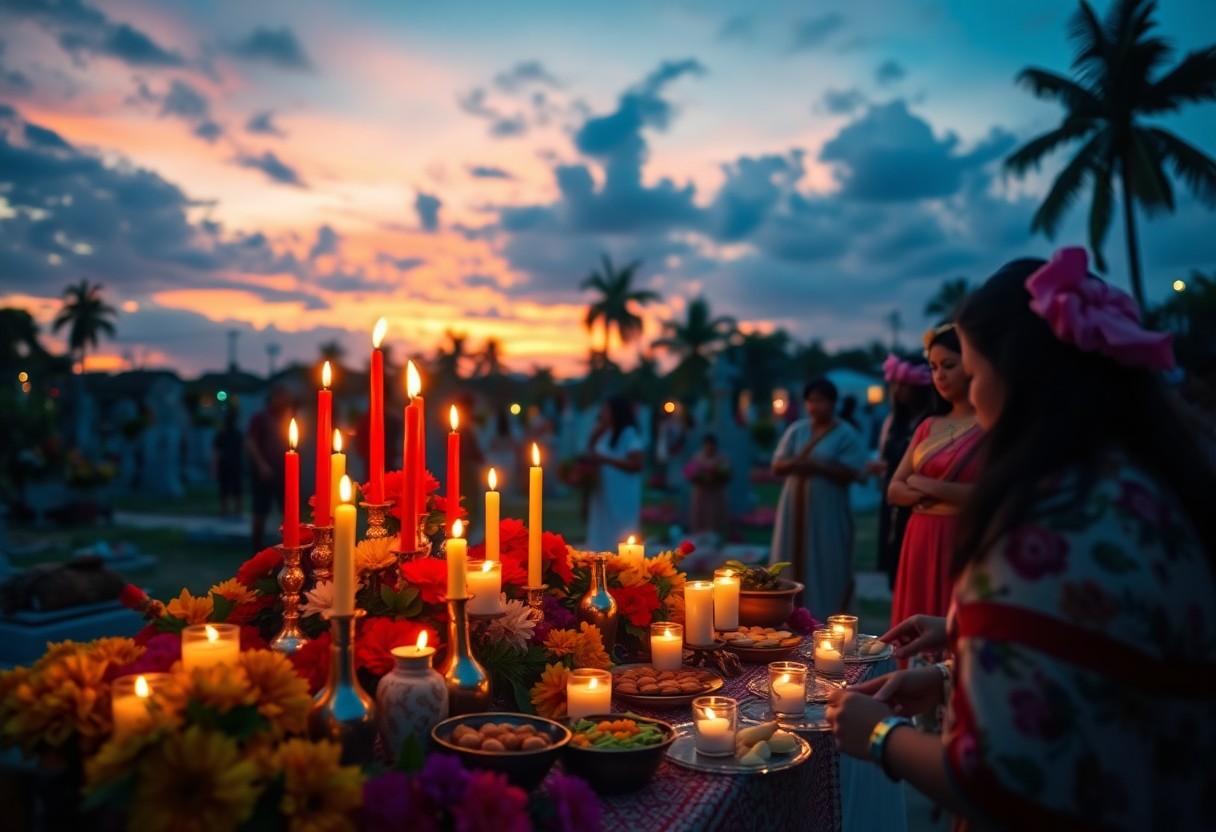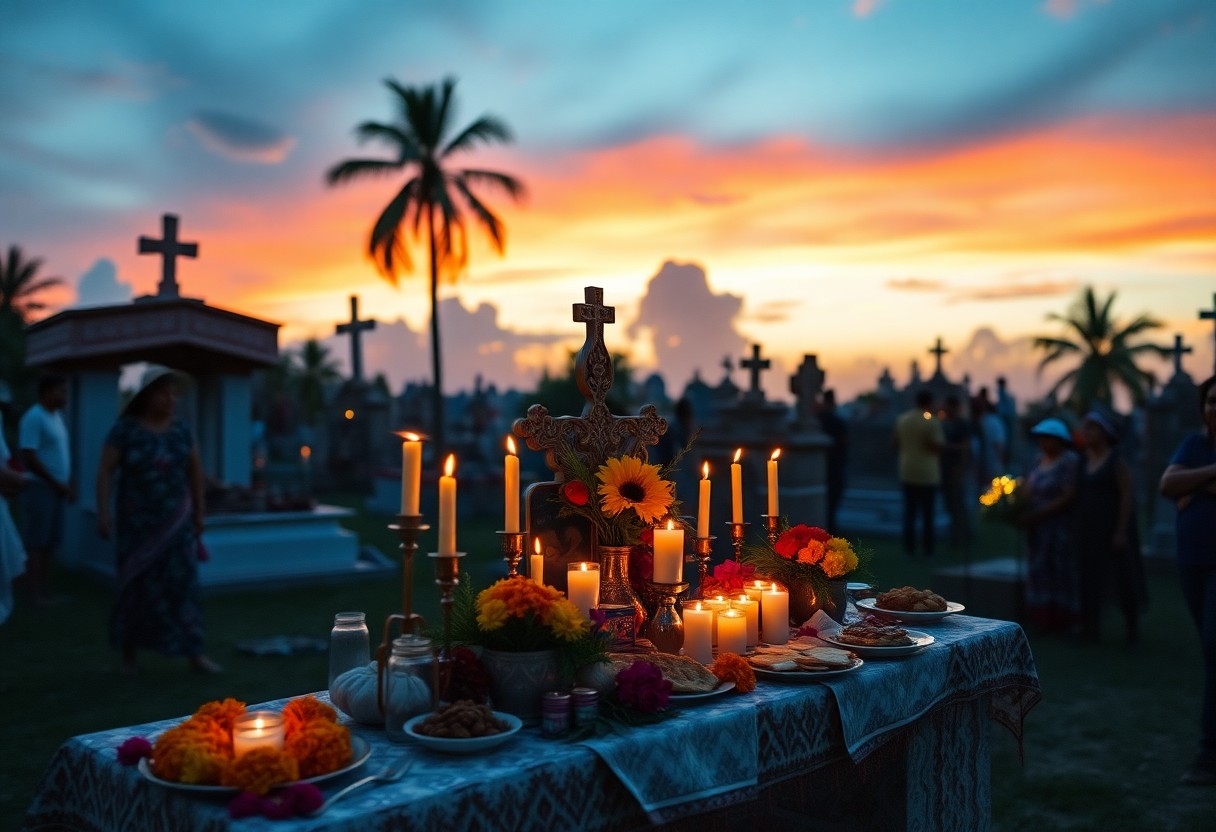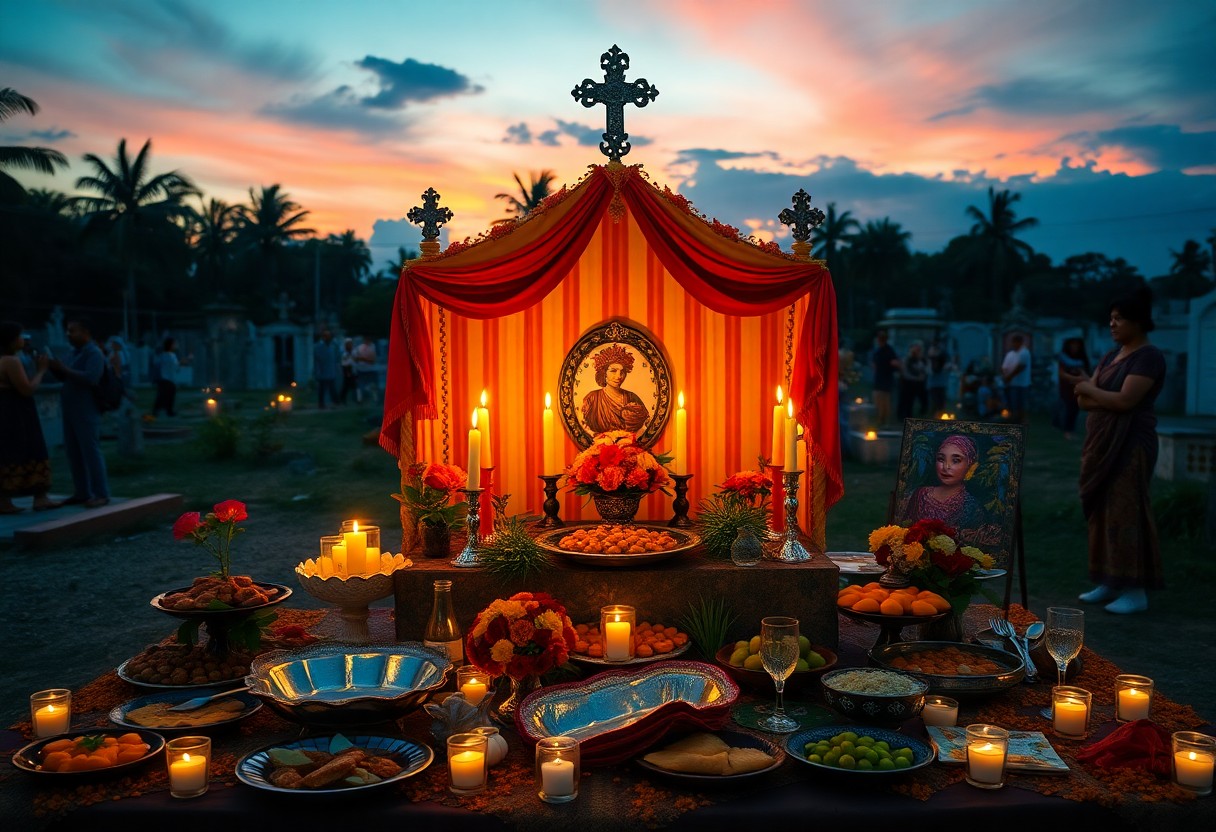The sacred tradition of Los Finados in Belize unfolds as departed souls return to Earth from November 1 to November 9. This remarkable celebration showcases a distinctive blend of Maya-Mestizo customs intertwined with Catholic practices in Northern and Western Belize. Families throughout the region come together to create stunning altars adorned with traditional offerings, inviting a deep exploration into this vibrant cultural celebration. You will encounter meaningful rituals, such as crafting las velas de cera (wax candles) to guide spirits home and preparing sacred dishes like ix’pasha and bollos. This nine-day observance not only honors the memory of loved ones who have passed but also reflects how Belizean communities sustain their profound connections with ancestral traditions.
Here’s the formatted content as requested:
Discover the Rich Variety of Los Finados Celebrations in Belize
To pay tribute to the departed in Belize, families engage in a variety of traditional ceremonies and ritual offerings throughout Los Finados. The celebrations harmoniously blend Maya-Mestizo customs with Catholic traditions, creating a rich tapestry of cultural significance. Key events during this period include:
| Celebration Type | Date |
| Día de los Angelitos | November 1 |
| Día de las Animas | November 2 |
| Daily Prayers | November 3-8 |
| Final Procession | November 9 |
Día de los Angelitos: A Heartfelt Tribute to Departed Children’s Spirits
One of the most poignant aspects of Los Finados centers around honoring children who have passed. Families create special altars decorated with toys, candies, and sweet bread, reflecting the innocence and purity of young souls. Adorned with white flowers and small angels, these altars serve as a vibrant celebration of life, providing a space for families to connect with their children’s spirits and celebrate their memories. This day is particularly emotional, as families gather to reminisce about the joys and laughter their children brought into their lives. The act of creating these altars not only honors the departed but also fosters a sense of unity among families and communities during this sacred time.
Día de los Animas: A Day of Remembrance for Departed Adults
On this significant day, offerings consist of traditional foods, beverages, and personal items belonging to deceased adults. Altars are adorned with ix’pasha, bollos, and las conservas, alongside cherished photographs and meaningful possessions. A crucial tradition involves the use of las velas de cera (wax candles), made from pure beeswax, which serve as spiritual guides for the souls. Their flames indicate the presence or departure of spirits, and it is essential that these candles burn completely without being extinguished. This day serves as a powerful reminder of the importance of community support in remembering and honoring those who have shaped the lives of their loved ones. Families share stories, laughter, and tears, creating a rich tapestry of memories that bind them together.

Master the Art of Creating Traditional Altars for Los Finados
Preparing an altar for Los Finados is a task that demands meticulous attention to detail and deep respect for ancient customs. Typically structured as a three-tiered arrangement, the altar symbolizes the connection between heaven, earth, and the underworld. Start your preparations at least two days before November 1st to ensure you have ample time to gather all the necessary elements, creating a sacred space that welcomes the spirits of the departed. This process allows families to reflect on their losses while actively engaging with their cultural heritage, reinforcing the bonds of family and community. Each element placed on the altar tells a story, merging personal memories with cultural significance.
Essential Elements and Decorations for Your Altar: A Guide
The little details in your altar will make a significant impact on its composition. Essential items include las velas de cera (beeswax candles), fresh flowers (especially marigolds), copal incense, and a white tablecloth to serve as your foundation. Incorporate photos of deceased loved ones, religious imagery, and traditional foods such as ix’pasha and bollos. Additionally, ensure the presence of water, salt, and bread, as these are fundamental elements that hold great significance in the rituals. The colors and fragrances selected for the altar play a vital role in creating an inviting atmosphere, encouraging the spirits to return home. This thoughtful preparation infuses the space with warmth and love, inviting reflection and remembrance.
The Deep Symbolic Meanings Behind Altar Item Placement and Arrangement
The placement of items on your altar carries profound spiritual significance within Belizean tradition. The top tier represents heaven, showcasing religious symbols and photographs of the deceased. The middle tier is dedicated to offerings of food and drink, while the bottom tier features water and salt to purify the visiting souls. Each candle’s position acts as a spiritual compass, guiding souls between realms and creating a harmonious connection with the spirit world. The careful arrangement of these items reflects the family’s beliefs and hopes, creating a sacred dialogue between the living and the dead. This intentional design allows families to express their love and devotion, fostering a sense of peace during this time of remembrance.
The elements on your altar work in unison to establish a powerful connection with the spiritual realm. The smoke of copal incense carries your prayers skyward, while the vibrant scent of marigolds creates a welcoming path for spirits to follow. It is important that your food and drink offerings are fresh and abundant, as these serve as spiritual nourishment for visiting souls during their journey from purgatory. The act of preparing and presenting these offerings embodies the deep respect and love families hold for their departed, ensuring their memories are cherished and honored.

Engaging in the Step-by-Step Ritual Process of Los Finados
To fully participate in Los Finados, it is essential to understand the specific sequence of rituals that unfold over the nine days of celebration. This process artfully combines Maya-Mestizo traditions with Catholic practices, resulting in a unique cultural experience that enriches your understanding of this sacred occasion. Each day holds distinct significance, allowing families to engage with their heritage while honoring their loved ones. Embracing this ritualistic framework deepens the communal bonds and fosters a sense of belonging among participants.
| November 1 | Día de Los Angelitos – Honoring deceased children |
| November 2 | Día de las Animas – Honoring deceased adults |
| November 3-8 | Daily prayers and offerings |
| November 9 | Final farewell ceremony |
Setting Up Your Altar with Purpose and Intention for the Spirits
Arranging your altar follows a specific order that reflects deep meaning. Place photos of your departed loved ones at the center, encircled by las velas de cera (beeswax candles). Incorporate religious items, fresh flowers, and traditional foods like ix’pasha and bollos across different levels. Position your altar facing east to invite the spirits to return. This thoughtful setup allows families to create a sacred environment that honors their loved ones while providing a welcoming space for their spirits. The act of setting up the altar becomes a communal activity, encouraging families to share stories and memories as they prepare.
Participating in Prayer and Offering Ceremonies with Reverence
Specific sacred guidelines govern your participation in the Los Finados ceremonies. Maintain silence during food preparation, as it is believed that spirits are present in the space. Only the cook may taste the ix’pasha porridge, and it is crucial that the candles burn completely without being extinguished. This reverent atmosphere fosters a deep connection to the rituals, allowing individuals to reflect on their relationships with the departed. Once your offerings are in place, you will join in nine days of prayers. Observe the direction of the candle flames—if they flicker eastward, it signifies the arrival of spirits, while westward indicates their departure. The food remains untouched until after prayers, at which point you can share the meals, as the spirits have already consumed their essence.
Delving into Traditional Foods and Offerings: A Culinary Connection to the Departed
Your connection to Los Finados is deeply embedded in the traditional dishes and offerings you prepare. In Belize’s Maya-Mestizo communities, food serves as a spiritual bridge that connects the living with the departed. Your offerings must consist of specific items: las conservas (stewed fruits), traditional corn-based dishes, and special beverages that your deceased loved ones cherished. Each dish holds its own unique significance, intertwining personal memories with cultural heritage, allowing families to honor their ancestors through the act of cooking and sharing meals.
Highlighting Special Dishes and Their Cultural Significance in Los Finados
As you prepare your altar, you will need to include ix’pasha, a revered purple corn porridge, and bollos, crafted from masa and ix’pelón beans. Your offerings should also encompass traditional sweets, such as bread and candies for los angelitos (little angels), along with more hearty dishes meant for adult spirits. Each item placed on the altar carries deep cultural meaning, symbolizing your respect and remembrance for those who have departed. These culinary traditions not only honor the dead but also serve to strengthen family bonds, as cooking and sharing meals become opportunities for storytelling and connection.
Guidelines for Preparation and Cooking: Honoring Tradition with Care
Even while cooking, it is important to adhere to specific traditional protocols. Maintain a quiet, reverent atmosphere as spirits are believed to be present during the preparation. Special care should be taken with the preparation of ix’pasha—only the cook may taste it before it is served after prayers. Gather your family together to prepare these meaningful dishes in a sacred environment. Never blow out the wax candles with your mouth; they must burn down completely. Ensure that your cooking is finished before sunset on November 1st for children’s spirits and by November 2nd for adults, so that your offerings are fresh and welcoming for the spirits upon their arrival.

Key Considerations for Engaging Meaningfully in Los Finados
When participating in Los Finados celebrations in Belize, keep in mind these essential elements. The tradition revolves around altar preparation, traditional foods, and sacred rituals. Your involvement necessitates a deep respect for both Catholic and Maya customs. Understanding the spiritual significance enhances your ability to connect meaningfully with this celebration, allowing you to truly engage with the community and its rich cultural heritage.
Understanding the Timing and Duration of Los Finados Celebrations
Los Finados follows a precise timeline in Belize, starting with November 1st for Día de los Angelitos and culminating on November 9th. The nine-day celebration provides families ample opportunity to honor their departed through daily prayers and rituals. To participate effectively, it is crucial to grasp the specific timing for offerings and ceremonies. This structured approach helps families navigate their grief while celebrating the lives of those who have passed, fostering a sense of continuity and belonging within the community.
Examining the Cultural and Religious Elements of Los Finados Celebrations
Los Finados intricately blends Maya-Mestizo traditions with Catholic beliefs, creating a profound experience during this sacred celebration. You will encounter traditional elements such as ix’pasha, las velas de cera, and altar preparations that highlight this unique cultural fusion. Respecting both spiritual aspects enriches your understanding of this important tradition. Each ceremony and ritual is steeped in history, revealing how these communities honor their ancestors while embracing their faith. Participation in such a multifaceted tradition deepens your appreciation for the vibrant cultural tapestry of Belize.
Key components of the celebration include preparing traditional foods, setting up memorial altars, and engaging in community prayers. Notably, the crafting of beeswax candles holds special significance, as they act as spiritual guides for the departed. The combination of food offerings, prayers, and communal activities fosters a deep connection between the living and deceased members of the community, reinforcing the values of remembrance and respect.
Essential Tips for Respectful Participation in Los Finados
For those unfamiliar with Los Finados customs, approaching this sacred celebration with the utmost respect is vital. When attending community events or visiting homes containing altars, maintain a respectful demeanor and seek permission before taking any photographs. Dress modestly, refrain from touching altar items, and adhere to local customs. Acknowledging the profound spiritual significance of Los Finados will enhance your participation in this cultural tradition, allowing you to engage more authentically with the community.
Practicing Cultural Etiquette During the Celebration: A Guide
Given that Los Finados is a deeply spiritual occasion, your behavior should reflect its solemnity. Speak in hushed tones near altars and during prayers, and opt for modest and respectful attire. If you visit cemeteries or homes, consider bringing flowers or candles as offerings, but always ask for the family’s permission first. Your sincere interest in understanding this tradition will be warmly welcomed by local communities, reinforcing the importance of respect and understanding in cultural exchanges.
Engaging with Common Practices and Customs During Los Finados
During your visit to Los Finados, you will observe specific customs unique to Belize. You can actively participate by assisting families in preparing traditional foods like ix’pasha and bollos, or by joining in the evening prayers. It is essential to never blow out las velas de cera (wax candles), as this act is seen as disrespectful to the spirits. This nine-day celebration invites your active participation in various customs. You can join families in placing candles along roadsides on November 9th, attend the Noche de Cuenta Cuentos, or explore the vibrant night markets. Always ensure that your presence at these events is accompanied by respect for local traditions and beliefs, fostering a sense of community and shared experience.
Reflecting on the Rich Significance of Los Finados in Belize
Upon reflection, you will find that Los Finados in Belize presents a unique opportunity to understand how Maya-Mestizo communities sustain their connections with loved ones who have departed. Through your exploration of this vibrant nine-day observance, you will uncover the rich tapestry of customs—from the preparation of traditional dishes like ix’pasha to the intentional placement of las velas de cera. Your newfound understanding of this cultural celebration reveals how Belizean communities harmoniously blend Indigenous wisdom with Catholic traditions, creating a meaningful method to honor their ancestors. Next time you find yourself in Belize during early November, you will appreciate the depth of these customs that preserve family bonds across generations and celebrate the lives of those who have shaped the community.
Frequently Asked Questions (FAQ) about Los Finados in Belize
What are the key dates and events during Los Finados in Belize?
Los Finados in Belize spans from November 1 to November 9. The first day, known as Día de Los Angelitos, honors deceased children with special altars featuring sweets and treats. The second day, Día de los Animas, celebrates departed adults with traditional foods such as ix’pasha and bollos. The celebration culminates on November 9 with candle-lighting ceremonies along roadsides and processions at cemeteries, bringing families together to remember and honor their loved ones.
What traditional foods and items are placed on Los Finados altars?
Los Finados altars showcase a variety of traditional elements: las conservas (stewed fruits including pumpkin, papaya, and watermelon), ix’pasha (purple corn porridge), bollos (corn dough with ix’pelón beans), wax candles (las velas de cera), flowers, photographs of the departed, and religious images. Additionally, the deceased’s favorite foods and beverages are included as offerings, creating a personal connection between the living and the dead.
How do Belizean communities maintain and celebrate this tradition today?
Communities in Northern and Western Belize preserve Los Finados through various engaging activities, including Noche de Cuenta Cuentos (storytelling nights), vibrant night markets, and altar exhibitions. The National Institute of Culture and History conducts workshops that teach traditional cooking methods and candle-making, ensuring that this vital Maya-Mestizo cultural practice continues to be cherished and passed down through generations. The commitment to preserving these traditions demonstrates the community’s dedication to honoring their heritage and maintaining connections with their ancestors.
The Article Remembering the Departed: Celebrating Los Finados in Belize appeared first on Belize Travel Guide
The Article Los Finados in Belize: Honoring the Departed Was Found On https://limitsofstrategy.com


What a beautiful portrayal of Los Finados! I always find it fascinating how traditions can blend elements from different cultures, creating something unique and meaningful. The way families come together to honor their loved ones through rituals and offerings resonates deeply with the universal human experience of remembrance.
It’s interesting how traditions like Los Finados not only celebrate individual lives but also weave together stories from diverse cultures. This blending can turn a simple gathering into a rich tapestry of memories and meanings. The way families incorporate personal touches—like favorite foods or sentimental items—can really highlight their unique connections. It’s a reminder of how we all share that desire to keep the memories of our loved ones alive, no matter where we come from. That universal thread of remembrance binds us in ways that words often can’t capture. What aspects of this tradition resonate most with you personally?
It’s so true how blending traditions often leads to something really special. Los Finados is a perfect example of how cultural exchange can deepen our understanding of life, death, and remembrance. I love how the altars, with their vibrant colors and personal touches, turn into a collective expression of love and memory.
It’s fascinating to read about the vibrant and meaningful tradition of Los Finados in Belize. As someone who has always been intrigued by how cultures honor their ancestors, I find this celebration to be an exceptional example of the fusion of indigenous and colonial influences that shape Belizean identity. The way families come together to create altars and offerings is such a beautiful reflection of love and remembrance.
I appreciate how beautifully you captured the essence of Los Finados in Belize. It’s fascinating to see how this celebration melds Maya-Mestizo and Catholic traditions, creating such a rich tapestry of cultural expression. The act of crafting las velas de cera really resonates with me; it’s a tangible way for families to connect with their ancestors, blending love and remembrance.